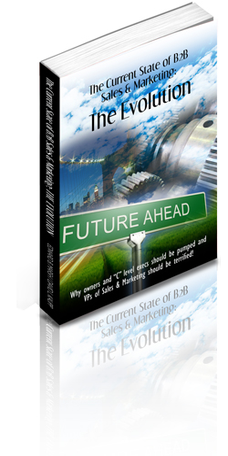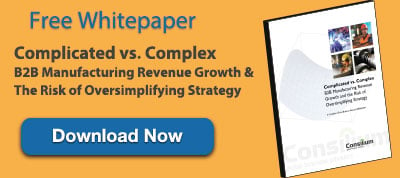Complex B2B sales - and yes/no digital marketing
Do buyers pick up your products like a pack of gum they notice while standing in a long checkout line at Home Depot on Saturday afternoon? Of course not.
Then why do you sell as though they do?
"Not fair!" you say?
Well, let's see. Someone arrives at your website. They find a bit of information about your product. They check the specs and they call you with a credit card number, right? Deal done. No 8 or 26 or 52 week buying cycle. No financial analysis. No engineering review. No implementation analysis. It's simple
Oh, it's not?
Well then have you wondered, how many you might be losing? If their buying process is complex and lengthy, and your response is so simple that it can be distilled into a "yes - your product happens to satisfy my requirement" or "no - it's not quite what I need", then how many 'no'" might you be creating without even realizing it?
It's a bit of an anemic business expansion strategy when you consider it from that angle, isn't it?
A series of "yeses"
Any substantive relationship is built cumulatively, on a series of progressively more significant agreements - in other words a series of 'yeses.'
That's what your direct sales team used to work on. For example:
- yes to take a cold call
- yes to a conversation
- yes to a meeting
- yes to discussing the business in more detail
- yes to another meeting
- yes to review proposal
- yes to make a decision
- and finally, 'yes' or 'no'
But since buyers now plow 70% of the way through their buying process online, without speaking to your reps (and often without even letting you know they're poking around your website since the only option you offer is a "contact us" form) there's no series of 'yeses.' And if you're not selling a pack of gum to do it your-selfers checking out at the hardware store, you're completely ignoring the reality of how buyers evaluate your products.
"OK" you say. "But if I've got to build this relationship without prospects talking to me, how in the world is that possible?"
Glad you asked - your 'marketing' needs to 'sell' virtually - both in quotes because both are now vestigial terms from a bygone era which don't apply to today's buying cycles!
The buying journey
When your direct sales team was accruing "yes capital" with prospects in person they had a pretty simple job. Generally they had to demonstrate themselves more knowledgeable than the prospect (whose only research tool was their network and Encyclopedia Britannica); establish baseline ethics; and position your solution as best among a spectrum of 3 under consideration.
Today buyers have access to vast volumes of information. They can instantaneously access expertise, case studies, product information, business advice, competitive analysis and a range of other info in whatever form (video, chart, long form, infographic, etc,) is most convenient for them to consume.
That drastically changes the process of "yes capital" accumulation - the yeses now are much more buyer focused. For example:
when searching the internet
- "Has anyone wrestled with this problem before?"
- "This looks like a possible answer worth clicking on"
- "Wow, this is exactly the kind of information I was looking for"
- "It sounds like they work in a space that's like mine, and understand my challenge"
- "That's an interesting perspective. Can you provide some more in depth information on that?"
- "What else do they do that might be of interest to me?"
and when exploring the site
- "Was this just a fluke or is this something they really understand?"
- "If they really understand me, then it should be pretty intuitive for me to find what I need. Is it?"
- "I'm short on time now, but want to learn more. Is that easy to do?"
- "Oh good. A (whitepaper, eBook, video, infographic - whatever I happen to prefer) is available. Let me grab that and dig in tonight after dinner when I have time."
- "Interesting - I didn't realize that another consideration was XXXX. I should probably check that out too."
after leaving the site
- "That was nice of them to reach out with a recommendation for other resources. I was afraid they were going to call me to try to sell me!"
- "Now that I understand a bit more about the problem I'm having, I'd like to see about some possible solutions. Where do I find that?"
- "This is going to take a lot longer than I thought - it's a complicated business problem. Is there information I can start to share with my colleagues to help them understand too?"
- "I'm not even sure what the best way is to evaluate options. How do I look at different solutions?"
- "OK, it seems like it's good, but would it really work here with the way we do things?"
- "How do I figure out what it's going to cost? And more importantly, what other costs should I be thinking of, and what's the return going to be?"
- "My finance folks will want to check my ROI calculations. Are there tools available to explain it better to them than I can?"
- "Can I somehow lay out for my (IT, operations, legal, risk, sales, etc) colleagues exactly what implementation will look like? Oh perfect, this webinar will answer their questions better than I can."
- "Is there a list of other companies like ours that have tried this? How well did it work for them?"
and finally...when it's time to talk to a sales rep
- "Please don't let this person ask 'how soon do you need it?'!"
- "Wow, I hadn't thought of that other impact on XXXX. That's a really important point to plan for."
- "It's such a relief to already know the details - I can ask the important detail questions now."
leading to the final...
Making it easy to buy
 That's the crux of your revenue growth efforts in today's market. People will buy according to their preference and requirements - not according to the process your org chart would rather dictate. And your business expansion strategy, therefore, must be built to mirror their buying journey.
That's the crux of your revenue growth efforts in today's market. People will buy according to their preference and requirements - not according to the process your org chart would rather dictate. And your business expansion strategy, therefore, must be built to mirror their buying journey.
For complex B2B products and services that buying journey is typically long and circuitous, and prospects are determined to take that journey on their own.
Your choice then, is whether you are willing to invest in helping people buy your solution. You can persist in your "Shamwow" style pitch - vomiting up a non-stop flow of self-centered, product based blather that simply repels prospects. (And yes, that's really what it feels like to buyers!) Or you can think of your website as the core of your revenue growth strategy and build a welcoming & informative resource - much like the tourist welcome center in a city which happily provides maps, insights and personally tailored recommendations.
Which do you prefer? I thought so.
Then why do you serve up stale product specs to your visitors?
Design your prospect/buyer experience to offer a series of 'yeses' and you'll find that finally you've created a business expansion strategy well suited to today's markets.
Want to learn more? Download our free book "The Evoltuion of B2B Sales & Marketing."

